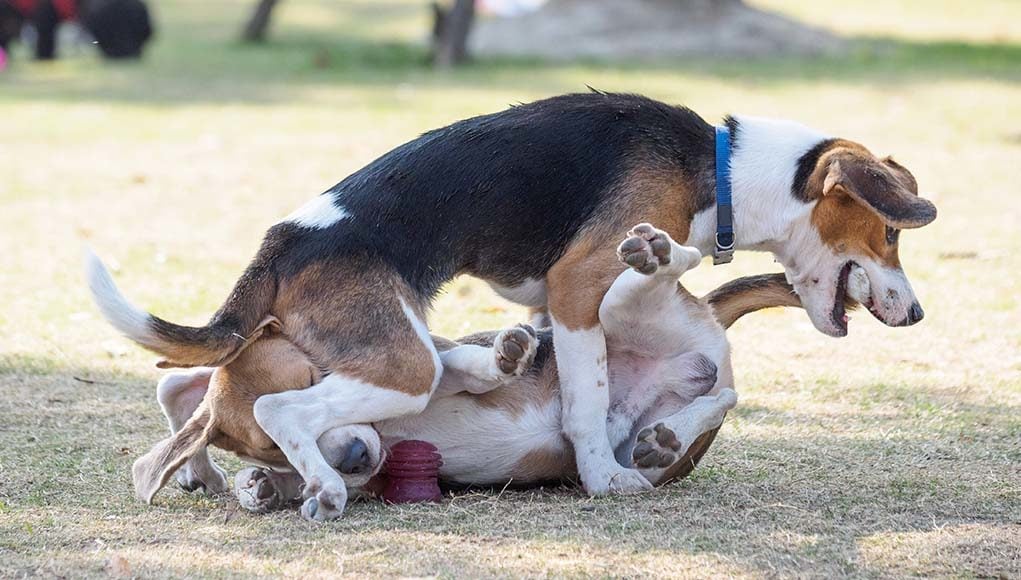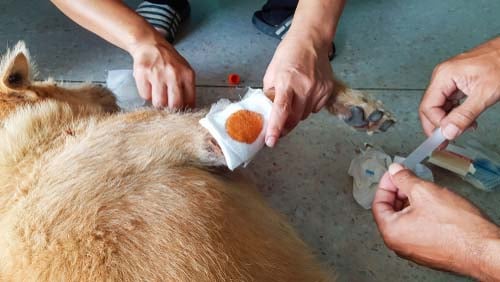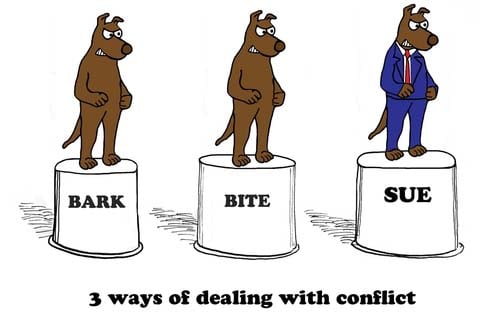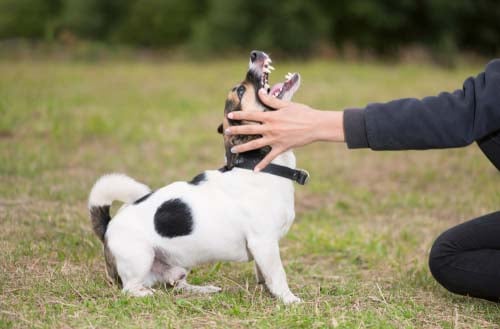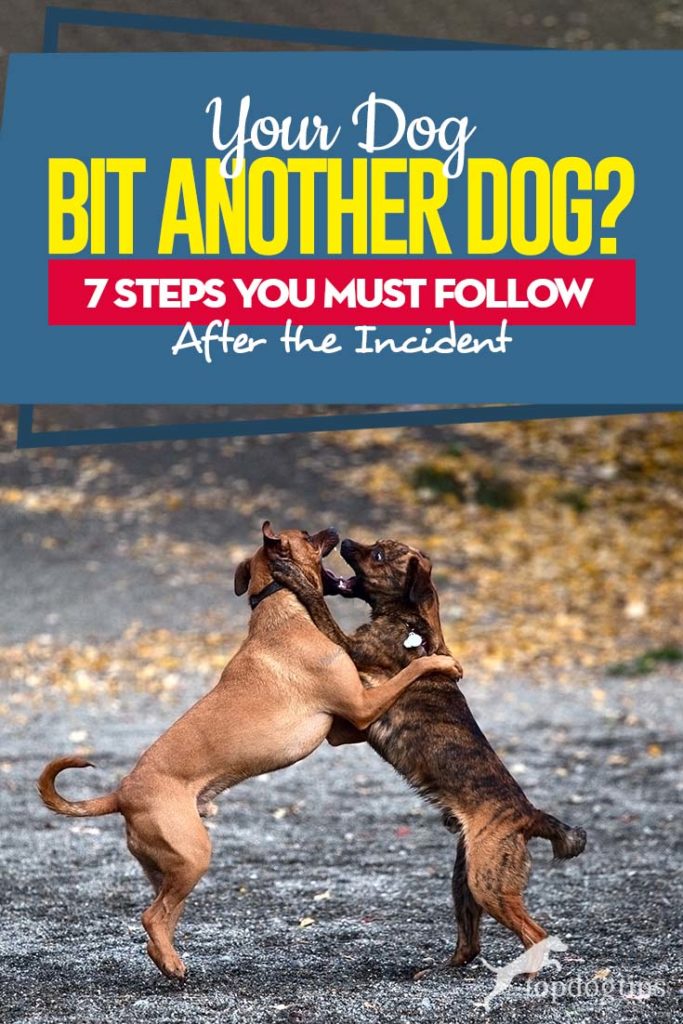You're in a dog park, and your pooch is playing with another dog. All of a sudden, the situation escalates and they start fighting. Within seconds, one of them hurt the other. This happens sometimes. And if your dog bit another dog, there are steps you must follow to help control and deescalate the situation.
There will be many things to consider, from taking care of your dog, tending to the wounds of the victim dog, dealing with the victim dog's owner and the outcome of this altercation, such as covering costs of the damage done by your pet. Dog bite, injury related lawsuits have risen substantially in recent years. From 2003 to 2015 alone, there was a 76% jump in claims from $324 million to $571 million.
Remember: Never get in between two fighting dogs. To break up a fight, use a hose, a bucket of water, or any liquid (soda) to separate them. If water is not available, use the wheelbarrow technique – each person grabs the hind legs of a dog and pull them apart.
Step #1: Take Control
The first step is to take control of your dog. If your pup is running loose, attach a leash and keep them close. Confining them is even better. If you are able to do so, put your dog in a vehicle (if you’re out) or bring them inside a house if it's close by. If your dog bit another dog in your home, confine them in a separate room or a crate.
The goal is to get each dog out of the other's sight. Separate and confine your pooch without otherwise punishing them. You'll need to first help the victim, and only then seriously consider and address the cause of this accident, and your dog's aggression (if there was any) at a later point.
Step #2: Check the Victim
If the owner of a bitten dog is around, leave this to them but remain close by. If not, stay calm and very carefully check the victim yourself.
Keep in mind that scared dogs are prone to lashing out, so take caution not to get bitten. If the dog can walk, allow them to do so, while checking the gait. Look for any bleeding and assess whether the animal needs immediate wound stabilization and veterinary care.
For small dogs, it's helpful to wrap them in a towel or blanket to prevent shock from the trauma of the incident while you assess the wounds. For large breeds, place them on a large blanket or sheet. This enables two people to lift the animal in case they cannot walk, or if they shouldn’t be walking.
Step #3: Assess the Wound
Dog bite wounds are at risk for infection. The location and type of the puncture will determine whether the dog needs immediate veterinary care or not.
Nicks and bites on the nose and mouth are usually superficial and heal very quickly. However, if your dog bit another dog on the legs, torso, neck or around a joint that is easily irritated, the animal should be taken to the vet.
Observe the victim for any more serious symptoms in case of internal wounds or internal bleeding. If the dog is vomiting, having difficulty breathing, or is lethargic, an emergency vet visit is necessary.
Step #4: Offer Assistance
Offer assistance to the owner of the victim dog in every way possible, but stay out of their way if asked so. If the animal is in immediate danger, you may be required to help dress the wound and stabilize the dog until the victim can be brought to the vet.
Tend to the wound. To clean a dog's wound, flush it with lukewarm salt water. Use a clean cloth or gauze, and apply firm pressure for five minutes or as long as necessary to stop the bleeding (you may have to do so while transporting the dog to the emergency vet, depending on the animal's state).
Wrap the dog up. If the puncture is in the chest (or anywhere close), you'll need to take care of this quickly. Use a dressing material and bandage the chest tightly enough to seal it and stop the bleeding if there is any.
Prevent wound licking. If the wound is in the abdomen and the internal organs are protruding, take extra care and do not allow the animal to lick at it. If you are able, rinse the area with clean lukewarm water and use a damp sheet to wrap the dog’s stomach and take them to the vet right away.
Whether the bite is serious or superficial, always be calm and courteous to the other dog owner involved in the altercation. At the very least, you should offer to take the injured dog to the vet, and you may need to pay for the vet costs incurred by the incident.
Depending on where you live and the circumstance, you're likely to be liable to cover the costs of the damage done. That may include:
- Veterinary bill(s)
- Costs of medications
- The damage caused by pain and suffering
- Any lost income for the victim's owner
- Any property damage (e.g. victim's leash or clothes)
Sometimes, the compensation will be reduced if both you and other owner decide that you both share the blame for the accident. This depends on many factors, including the state you're in, individual circumstances, whether there's going to be a lawsuit and more.
Step #5: Get Witness Statements
Have any bystanders that witnessed the situation give their statements in writing along with their contact information. Chances are the victim dog's owner won’t pursue legal action, but if they do, you will need details by anyone that can corroborate the incident.
There are several ways you can go about this, and many different possible outcomes. Be familiar with them, and expect some of these situations to arise so you're prepared.
If the dog owner involved wants to sue you, and it happened on your property, remember to check your homeowner’s insurance to see if you have coverage.
In the case of a lawsuit, it's handy to have photographs of the victim’s injuries. Use a cellphone to document the bite (close up) and any other injuries that may have occurred. Enable phone's date and time stamp function to document the time-frame of the incident.
Step #6: Exchange Information
Get as much information as possible from the victim dog's owner, and provide them with the same – whatever's essential.
The information will include whether the victim animal is up to date on their vaccinations, particularly rabies, and the other person’s contact information. Provide the victim dog owner with your pet's medical information and vaccination records as well as, including your contact information.
Step #7: Call Animal Control or Police
Check your local laws (e.g. San Antonio, TX laws). Depending on the state or country you live in, you may be required to contact either animal control to report the incident, or the police if the dog owner was involved and got injured as well.
Either local authority may also have added requirements. Be sure to fully comply with their requests to make this easier on yourself in the future, should this go to court, and to prevent your pet being labeled as “dangerous dog.”
Animal Control will be concerned with whether your dog is vicious or dangerous to the public as a whole. They will also want to know if the bite was “provoked” or “had reason.” Contacting them by yourself (instead of the other dog owner) gives you a better chance of keeping this process fair.
After the Bite – Getting Back to Normal
To avoid another dog bite incident, identify what triggered your pet it in the first place.
If the dog “fight” was between two canines in the same household, what led up to the attack? Did one dog get spooked by something, or were they “fighting” over a favorite toy or treat? Never punish “the biter” as this action can make them more anxious and afraid. Instead, you'll have to employ training techniques, or even seek help of a canine behaviorist.
Knowing your dog and having the ability to read your pet’s body language is key to preventing dog bites and dog fights in the future. For example, if your pooch is not comfortable around strange dogs (dog parks, dog daycare), then don’t put them in that situation until you've work this issue out – the fight or flight response is very real.
Always be prepared to switch your plans if necessary and don't risk an animal fight. For example, if you know your pet isn’t comfortable with large crowds of dogs (like at a dog park) then change your plans and go for a leashed walk instead. Also, do not discount this issue as your pooch simply being “unsocial.” To be around other animals and people, the dog must be trained and socialized on a regular basis.
READ NEXT: How to Introduce Your Puppy to an Existing Dog


